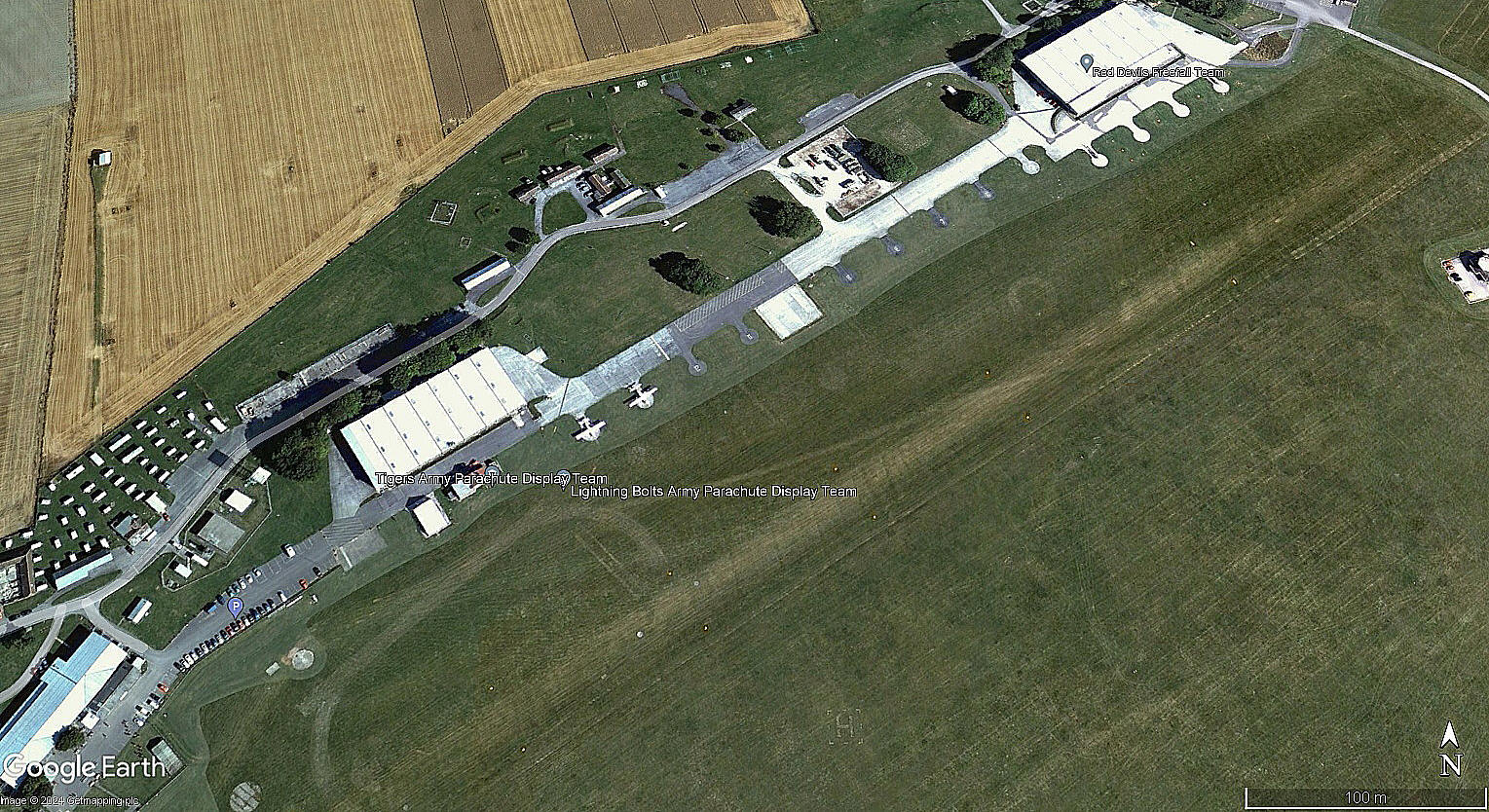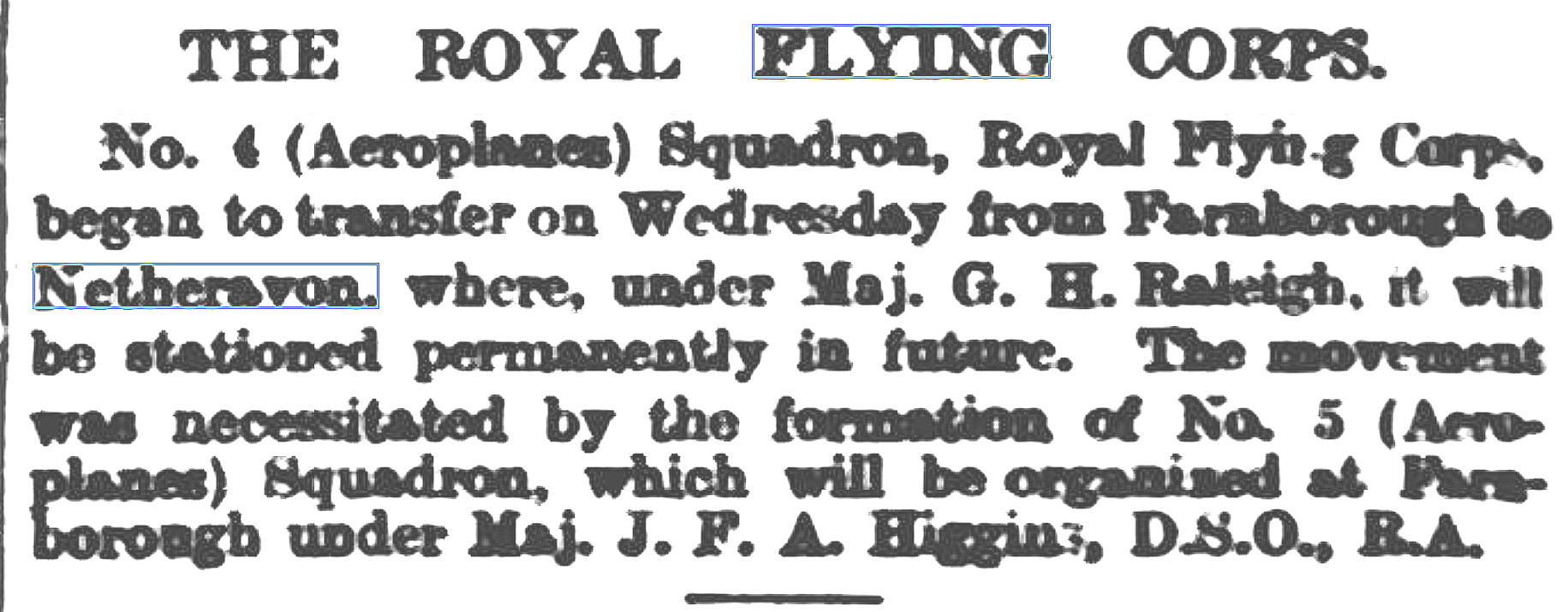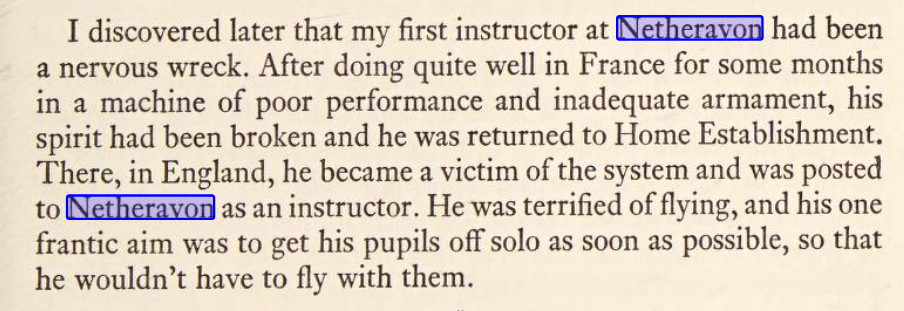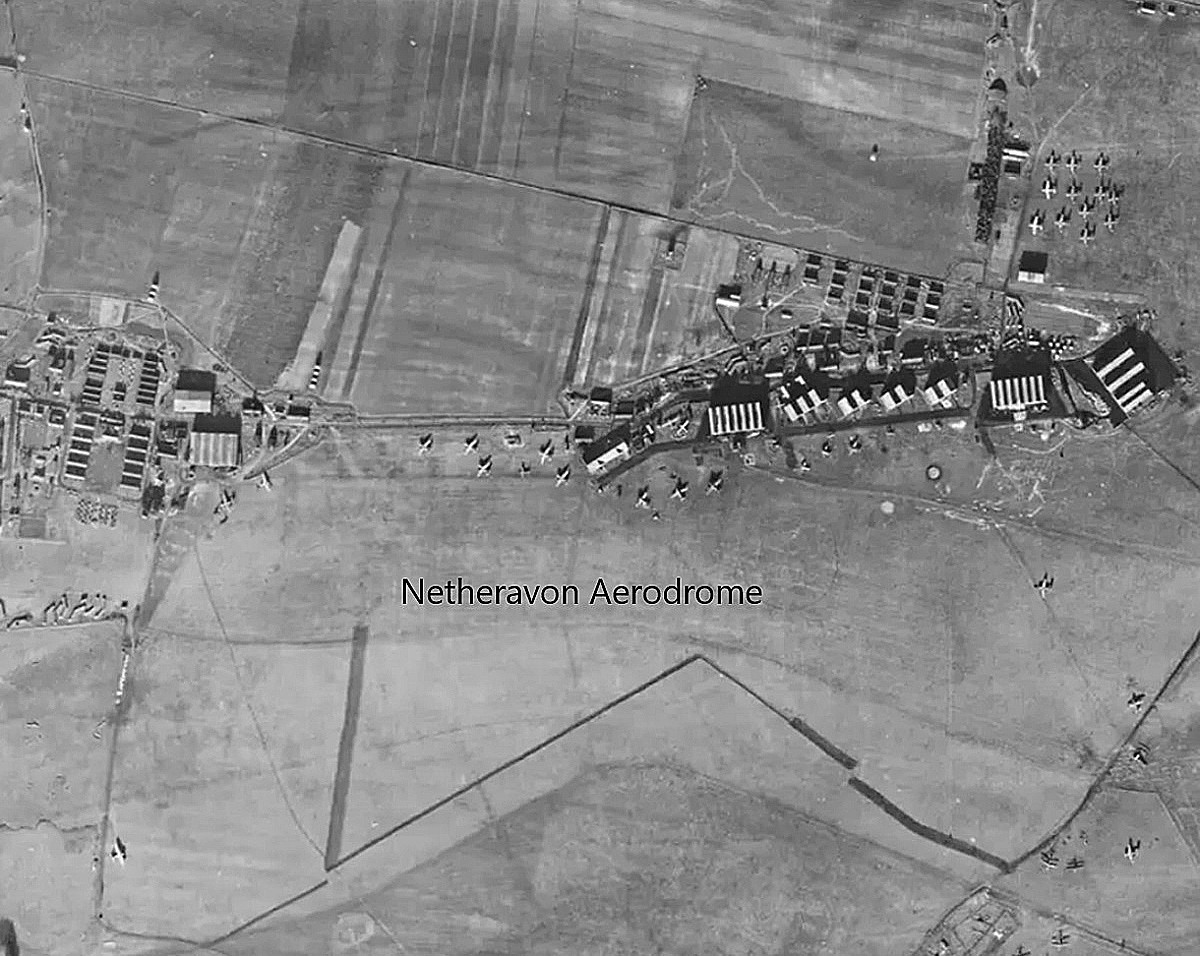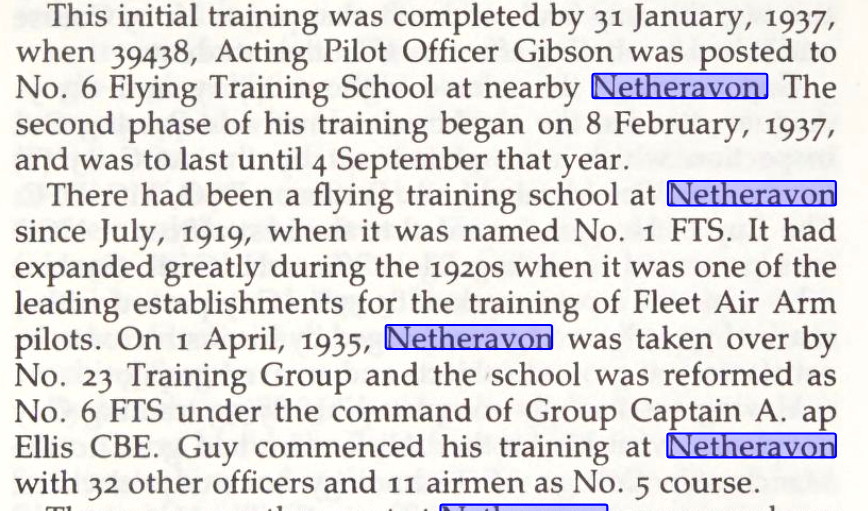Netheravon
NETHERAVON: Military aerodrome (Aka BULFORD CAMP)
The 2008 aerial view and 2005 aerial detail were obtained from Google Earth ©. The local area and area views are from my Google Earth © derived database. Please note that not all the locations listed in this 'Guide' are marked on this database.
This picture was scanned from The Pageant of the Century published in the mid 1930s, and kindly loaned to me by Mr Ed Whitaker. Included in the 1914 - 1918 Great War section, I would guess that the picture was taken earlier in the war? The aircraft in the foreground is a Royal Aircraft Factory B.E.2 type.
A MICHAEL T HOLDER GALLERY
Up until April 2024 this listing had not been provided with illustrations. Noticing this rather serious omission, Mike very kindly set about seeing what he could find - and here are the results.
THREE MAPS FROM 1922
Photo One is of a Royal Aircraft Factory BE.2a. Courtesy of Flight International. Article One was published in the Nottingham Evening Post on the 18th March 1913.
The aerial photo is courtesy of the RAF Museum.
The short article was published in the Evening Mail on the 20th June 1913. Photo Two is an Avro 504K of No.1 FTS (Flight Training School). Article Three was published in the Leicester Daily Post on the 4th September 1913.
Photo Three, entrance to the Officers Mess, courtesy of the RAF Museum. Article Four was published in Flight magazine on the 29th November 1913. Photo Four was published, also in Flight magazine on the 5th June 1914.
Excerpt One, "Instructor problem", is from Sopwith Scout 7309, by Sir Gordon Taylor. Photos Five and Six are from Handley Page Bombers by Chas Bowyer. Photo Five is of a 0/400 from NETHERAVON visiting RAF WADDINGTON.
Excerpt Two is from Dambuster - A life of Guy Gibson, by Susan Ottoway.
The 2022 aerial view was obtained from Google Earth ©. The area view is from my Google Earth © derived database.
Military users: WW1: Army (RFC) later RAF Training Squadron Station
CFS (Central Flying School) Annexe
RFC/RAF Training Depot Station and School
11 Sqdn (Vickers FB5s)
Note: In his most excellent book For Valour - The Air VCs, Chaz Bowyer tells us in the chapter on Lionel Wilmot Brabazon Rees that: "On the 30 October (my note 1914) in the same year his promotion to Captain was promulgated. His natural ability as a pilot brought him an immediate posting to Upavon as an instructor on the Central Flying School, but his stay was brief, and at the turn of the year he moved to join 11 Squadron RFC, then in the process of formation at Netheravon as the RFC's first 'fighting' squadron, and eventually equipped throughout with two-seat Vickers FB5's."
"Officially formed on 14 February 1915, 11 Squadron moved to France on 25 July , and became based at Vert Galand aerodrome, near Amiens."
12 Sqdn (Flying what?)
19 Sqdn (Royal Aircraft Factory BE2c & RE.7s)
21 Sqdn (Royal Aircraft Factory RE.5s & RE.7s)
32 Sqdn
Note: Chaz Bower, in his history of Lionel Wimot Brabazon Lees, then tells us that: "After a spell of leave, Rees was notified of his new appointment, as commanding officer if a newly-forming fighter unit, 32 Squadron. The nucleus of the new squadron was formed at Netheravon on 12 January 1916 and Rees arrived on his unit on 1 February. The intention was to form a complete, single-seater fighter unit for service in France, and on the 13 February the first example of the unit's equipment, a De Havilland 2 'pusher' scout was received at Netheravon."
"By 26 May the squadron's complement of machines and personnel was complete, and two days later the pilots flew their DH2s to Dover, (My note: Presumably SWINGATE DOWNS?), and then across the Channel to St Omer."
115 Sqdn (Handley Page 0/400)
Note: It seems that at some stage 115 Sqdn had a short presence here, equipped with Handley Page 0/400 bombers. They had been formed to fly the type at CATTERICK (YORKSHIRE) so their stay here was probably rather short before moving to CASTLE BROMWICH (WEST MIDLANDS). The Squadron was disbanded at FORD JUNCTION (SUSSEX) in October 1919.
1919 to 1939: RAF Training Command ‘Bomber Squadrons’
33 Sqdn (Hawker Horsleys later Hawker Harts)
Note: It appears that in 1929 33 Squadron were reformed here, but, in 1930 they were the first Squadron to receive the Hawker Hart, a light-bomber which was faster than the RAF fighters at that time.
57 Sqdn (Hawker Harts)
207 Sqdn (Handley Page 0/400s)
From at least 1928: 11 Sqdn (Hawker Horsleys later Fairey Fawns)
13 Sqdn (Armstrong Whitworth Atlas)
6 FTS [Flying Training School] (Hawker Furys and Hawker Harts
Fleet Air Arm (Avro 504Ks)
WW2: RNAS Training Station (Fairey Battles)
RAF Fighter Command
38 (Airborne Forces) Group
No.1 Heavy Glider Servicing Unit (Hamilcars/Horsas)
12 & 13 Glider Servicing Echelons (Horsas)
296 Sqdn (Hawker Hectors & Harts towing Hotspur transport training gliders)
297 Parachute Exercise Sqdn
Post 1945: AAC 7 Regiment (Volunteers)
658 and 666 Squadrons (Volunteers)
1960s: 667 Army Aviation Sqdn (Scout, Sioux and Alouette helicopters)
Fixed wing: (DHC-1 Beavers and DH89A Dragon Rapide fixed wing, over 50 aircraft in total)
1975: AAC (Scouts & Alouettes)
No.2 Flight (Gazelles) 656 Sqdn (Gazelles, Lynx) 658 Sqdn (Gazelles, Scouts)
Gliding: Listed as operating in 1975
Location: E of the A345, 6nm N of Amesbury, 13nm W of Andover.
Period of operation: 1913 to -
Site area: WW1: 283 acres 2076 x 475
Runways: WW2: E/W 1829 grass NE/SW 1280 grass
SE/NW 1372 grass
2000: 04/22 640x28 grass 11/29 1092x34 grass
NOTES: In his excellent book RAF Hendon Andrew Renwick records that one of the Blériots built in the Grahame-White ‘factory’ at Walham Green (Fulham, London) was sold, in 1910, to Bertie Fulton of the nearby Bulford Camp. To date no record appears to exist of exactly where Fulton flew the Blériot so it is just conjecture that he may have used this site?
The first official record I have found was when Henry Vaughan Jerrard (1st Class Air Mechanic) was granted Pilot Certicificate No.538 here on 2/7/13 flying a B.E. 201 biplane.
RFC STRENGTH
C C Turner gives an account of the strength of the RFC when WW1 was declared: “About seventy aeroplanes and over 600 officers and men of the Royal Flying Corps encamped on Salisbury Plain, in June, 1914. This was a mobilisation of Nos. 2, 3 4, 5, and 6 Squadrons. Squadron 2 travelled from MONTROSE to NETHERAVON (my capitals) accompanied by complete motor road transport of twenty-four vehicles, besides officers ’cars.” – “Squadrons 5 and 6 travelled by air from FARNBOROUGH.”
“If the full paper strength of the Royal Flying Corps had been realised the assembly of five squadrons would have brought together 125 aeroplanes, about 125 motor vehicles, and 1,100 officers and men.” Modern estimates reckon this was more like 113 aircraft. Four years later, when the Armistace was declared the RAF had about 22,000 aircraft on charge!
INFORMATION AND A PLEA
The following is copied from the excellent book, British Aviation - The Pioneer Years, by Harald Penrose, first published in 1967.
"Not long before Col. Seely had resigned as Secretary of State for War he had said when introducing the Estimates for 1914: 'With regard to aviation, I have asked the House, (my note - House of Commons), to sanction a very large estimate indeed - £1,000,000 - for aviation. In order that it should be safe it has got to be very expensive, for you cannot improvise an air service. We have been laboriously building it up for more than two years. I honestly believe that the British Army has now got an efficient air service, and that it will continue to have it so long as there are men determined to make any sacrifice in order to ensure that we shall not fall behind in quality."
"I say nothing for the moment as to quantity, but that is another question - in this great problem of mastering the air for the purposes of war." Col. Seely can perhaps, be understood for 'fluffing' the quantity issue. See my notes in FARNBOROUGH for the situation in mid 1913. Things had improved somewhat but the German and French air forces still vastly outnumbered the Royal Flying Corps and Royal Naval Air Service. And of course, in those days, the British Empire and the Dominions covered the largest area of the earth that any Empire before or after has ever seen. Quite probably this explains in part, as well as having a vast Navy, why the British Government had been so complacent about aviation fit for a vast European war - which so many well informed people were convinced was inevitable.
A PLEA
I wonder if any response was received? 'Here, if I may, I would make a public appeal to anyone who may hear me, or read what I say, to assist us in one vital matter with regard to cross-country flying. We have got the most difficult country in the world to fly over, not only because is the most windy and gusty, but also because it is the most cut up with hedges. If any landowner or farmer has got a suitable field, if he will communicate with me or with General Henderson, at the War Office, I shall be most grateful. We should like to have the opportunity of making a large number of landing places all over England, Scotland, Wales and Ireland in order to increase the safety of cross-country flights.'
What a most extraordinary statement to make - displaying total ignorance of the realities. And, this man was in charge! Very generally speaking the UK is one of, if not the easiest country in the world to navigate around - natural features abound to make it a doddle. Only controlled airspace, of ever increasing complexity in more recent years, makes it fraught with navigation problems. Even assuming some people did offer suitable fields, how on earth did Col. Seely imagine pilots in those days, without proper if any charts, let alone a compass that could be relied upon - if fitted - could find them when engaged on a long cross-country flight?
We need to remember, as an example, that when the Daily Mail offered a substantial prize, just a couple of years or so before, for the first aviator to fly from London to Manchester, the railway companies generously painted the track sleepers white for the two competing pilots to follow.
PROOF IF PROOF WERE NEEDED
Very conveniently, Harald Penrose then provides a fabulous example to prove my point: "The premier R.F.C. Squadron No.2, now fully equipped with B.E.2a's, received orders to participate in an overall mobilisation of the Military Wing on Salisbury Plain. On 11th May ten machines took off, led by the C.O., heavily built Major C.J. Burke. Thirty-four transport vehicles with tools, spares, and remaining squadron personnel began the drive to the first of the pre-arranged overnight stopping-points for the aircraft. Engine trouble caused Burke to return to base, but the remaining nine reached Edinburgh, and he caught up with them at Berwick next evening with news that the first R.F.C. air collision had occurred that afternoon at Farnborough, resulting in the death of one pilot and his air mechanic and serious injuries to the other pilot, both of whom were flying standard Gnome-powered 3-seat Sopwith tractors."
Incredibly, in aircraft design until several decades later, and even today to some extent, designers are not much interested in providing the pilot with the ability to look around, both for navigation and avoiding a collision. It is a risk every pilot in training has to accept, especially when flying in 'open' and uncontrolled airspace, but, has history has proved, collisions can still occur in 'so called' controlled airspace. And, think about this, the first stage was only planned from Montrose to Edinburgh, just around 100 mles! To be flown in one day!!
"Continuing their journey on the 13th, the Squadron reached Blyth and on the fourth night camped at West Hartlepool." In effect I think the squadrons progress was determined by the pace of the ground support convoy. Very roughly covering around 100 miles a day, which seems about right considering the state of the roads in those days. And having vehicles, probably not much capable of exceeding 20 m.p.h at best.
"Next day, flying to York, they encountered thick fog. One pilot and his mechanic were killed when their machine hit a hedge at speed, and two of the more experienced pilots wrecked their B.E.s when forced-landing, though without personal injury, while another damaged his undercarriage in similar circumstances. When the fog cleared, Major Burke concentrated the surviving aeroplanes at Knavesmire near York, where a week was spent repairing the damaged undercarriage and awaiting two replacement B.E.s, which arrived on the 19th May"
"Three days later the nine reached Lincoln but were delayed a day by heavy rain before continuing to Northampton. Eventually all arrived at Netheravon by way of Oxford on 30th May. Although this tragically disasterous journey of 500 miles was primarily an exercise for the Squadron's mechanical transport rather than a test of pilots and machines, the overwhelming lesson was the imperative need to institute an adequate nationwide meteorological service. Growled Burke: "We must fly when it is our duty to fly." It is of course probably difficult, given the weather forecasting we have today, to imagine flying any major distance without anything available. Clearly, although telephone/telegraph communication was available, the idea of getting en route weather by this means had not occurred to anybody.
THE RFC DEVELOPS
Here again I will quote Harald Penrose: "Throughout the spring and summer the strength of the Military Wing of the R.F.C. developed rapidly, thanks to the organising ability of General David Henderson at the War Office. When in June the R.F.C. Military Wing had their combined camp at Netheravon, there were 700 officers and men present from the Headquarters Flight, Aircraft Park, and Nos, 2, 3, 4, 5 and 6 squadrons. Although No.6 was neither up to strrength nor adequately equipped, the other four were numerically strong with B.E.s, Avro biplanes, and Maurice and Henry Farmans, as well as a limited number of Sopwith tractors and Blériot monoplanes."
What I hadn't realised, until reading British Aviation - The Pioneer Years, was that when the Royal Flying Corps was formed it included both the Army and Naval Wings - which was clearly a very poor decision. I expect this was a decision made by a pen-pusher in Whitehall who hadn't a clue about how the Army and Navy functions. As Harald Penrose tells us: "In June the R.F.C. Military and Naval Wings were officially seperated, so that each could adopt methods and equipment best suited to their individuality."
"The Admiralty announced the formation of the Royal Naval Air Service - comprising the Air Department of the Admiraly, the Central Air Office, the Royal Naval Flying School, and the Royal Naval Air Stations. All seaplanes, aeroplanes, and airships which from time to time might be employed for naval purposes were henceforth to belong to the R.N.A.S." Flight in its editorial leader said: 'Undoubtedly this important departure - "experiment" it has been called, though we dislike the term as we can see nothing of the really experimental about it, but rather the outcome of well considered judgement - springs in great part from the keen personal interest which has been manifested in flying by Mr. Churchill ever since he took office as First Lord of the Admiralty.'
'No Minister of our time has been at so much pains to become thoroughly acquainted with the work of his department as the present Head of the Navy, with the result that probably no First Lord has at any period had so deep and thorough knowledge of the work and needs of the Navy as Mr. Churchill.' "Henceforth the Central Flying School would be operated solely by the War Office, and Eastchurch would become the Flying School for the R.N.A.S., of which all personnel must be naval and its officers must serve a term every year in a ship of war at sea,"
LIONEL WILMOT BRABAZON REES
Lionel Rees was the seventh pilot to be awarded the Victoria Cross for aerial operations during WW1. As Chas Bowyer tells us in his excellent book For Valour, The AirVCs: “Promoted to Lieutenant on the 23 December 1906, Rees spent two years (1913-14) with the West African Frontier Force on active duty, but had already shown great interest in the new military ‘arm’, aeronautics, and learned to fly at his own expense; obtaining Royal Aero Club Certificate No 392 on 7 January 1913.”
“On return from his African detachment, Rees promptly applied for secondment to the Royal Flying Corps and was officially transferred on 10 August 1914. On 30 October in the same year his promotion to Captain was promulgated. His natural ability as a pilot brought him an immediate posting to Upavon as an instructor on the Central Flying School, but his stay was brief, and at the turn of the year he moved to join 11 Squadron RFC, then in the process of formation at Netheravon as the RFC’s first ‘fighting’ squadron, and eventually equipped throughout with two-seat Vickers FB5s.”
“Officially formed on 14 February 1915, 11 Squadron eventually moved to France on 25 July, and became based at Vert Galand aerodrome, near Amiens.” Right from arriving here Rees set off on aggressive combat sorties. Chas Bowyer describes in considerable detail Rees combat sorties, especially the day, on the 1st of July 1916 which resulted in Rees being recommended for a VC, which was of course awarded. And on this day: “….preceded by an artillery barrage of an intensity never before seen in France, the first battle of the Somme commenced.” I am writing this one day before the centenary of the British declaring war on Germany.
BETWEEN THE WARS
In 1930 Mr John E Crossland McClure of 41 Squadron owned the Westland Widgeon Mk.II G-EBJV, (which took part in the 1924 Lympe trials), and based it here for a year or two.
On the 23rd May 1933 the Danish parachutish John Tranum ‘borrowed’ a Hawker Hart and set a world record, jumping from 20,000ft.
In the early to mid 1930s the dual-control Armstrong Whitworth Atlas type was used by No.13 squadron for flying training
WORLD ALTITUDE RECORD
The world altitude record by the Bristol 138A, 53,937 feet, was undertaken here it is claimed, flown by Flt. Lt M J Adam on the 30th June 1938.
THE TIP OF AN ICEBERG
One of the most basic aspects of operating an Air Force I always tend to lose sight of is that the actual flying of aircraft is only the tip of a very big ‘iceberg’. For example, and even this is basically to do with flying of course, in late 1944 NETHERAVON was home to 38 Group Parachute Maintenance & Servicing Unit, 1, 4, 6 & 7 Mobile Parachute Servicing Units, the Air Transport Tactical Development Unit and the RAF School of Air Transport.
Supporting all this activity is a massive administrative structure devoted to maintenance and supply of every kind imaginable which I think we now tend to generally disregard. Not really appreciating the crucial importance of all those employed in often very mundane duties, especially when looking back to WW2 with our ‘hindsight’ tinted by ‘rose coloured spectacles’.
CIVIL AIRCRAFT
A tad intriguing in 1975 NETHERAVON was listed as being available to private aircraft and I later discovered that in 1977 DH.89A Dragon Rapide G-AGTM of the Army Parachute Association, and another Dragon Rapide G-AIDL, (in a 1977 register apparently belonging to the Midland Metal Spinning Co?), were based here. Along with DH.82A Tiger Moth G-AJHS of the R.A.E Aero Club, BN-2A Islander G-AXHE of the Rhine Army Parachute Association plus another Islander G-AYRU of the Joint Services Parachute Centre and Cessna U-206F G-AZRZ also of the Army Parachute Association. So obviously at that time NETHERAVON was a major parachuting centre - albeit for members of the British Armed Forces. In more recent years an ‘Aero Club’ was established with members having an abundance of Austers it seems.
However, it appears that in March 2009 the airfield, the longest continuous serving airfield in RAF history, will close. Possibly the ‘Aero Club’ will continue?
A GHOST STORY
As pointed out elsewhere no ‘Guide’ to British flying sites would be complete without a few mentions of the ‘para-normal’, with at least a few ghosts hanging around. Elseswhere, despite often being very critical of it, I have nevertherless included stories from Military Ghosts by Alan C. Wood. He cites this example which started his interest in the subject of the para-normal and ghosts in general: “The author – then an eighteen-year-old airman – was posted to RAF Netheravon in the 1940s, and allocated a barrack room bed space in one of the wooden huts immediately on the edge of the airfield. Ten other airmen were billeted in the same hut, all of the same age. Being young fit airmen, all slept well in the comfortable billet, but were accustomed to being awakened at short notice for duty."
"One night, I was fast asleep in my bed, when I awoke for no reason. The room was dark, but with night vision it was easy to see the whole room without putting on the lights. Standing at the bottom of my bed was a dark figure dressed in First World War flying clothing of a primitive nature. I sat up in bed and stared at the figure. It did not move. I was not afraid. Being young, fit and unafraid of anything I roared expletives at the figure, which, perhaps startled at my aggressive behaviour, moved and faded away! Bedlam broke out as the other airmen awoke, but promptly went back to sleep when I said I had seen a ghost! Rude words were hurled in my direction. I went back to sleep.”
I have no reason to doubt this story. Indeed one encounter with the ‘para-normal’ shared with my wife many years ago in southern France was distinctly much more frightening and no rational explanation could even begin to unravel that phenomenom. This has led me to keep an ‘open mind’ regarding such affairs, despite in general remaining highly sceptical
We'd love to hear from you, so please scroll down to leave a comment!
Leave a comment ...
Copyright (c) UK Airfield Guide















